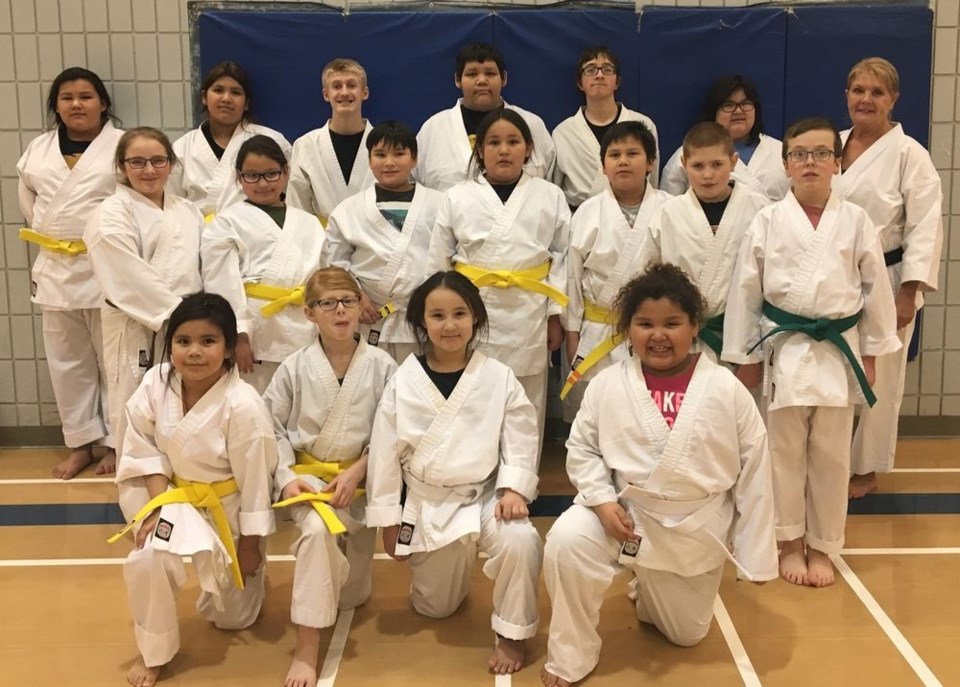The Kamsack Karate Club currently has 31 members, according to Matilda Kayseas, club president.
The Club holds practice two times per week in the Kamsack Comprehensive Institute’s gymnasium No. 2, on Mondays and Wednesdays, having begun in October, and running until May.
Members of the Club will be competing at the Parkland Karate Regional and Open district tournament in Esterhazy on April 6.
The top 10 reasons martial arts benefits children, by Kenny Myers, are:
- Fostering self-discipline. One of the central tenets of all forms of the martial arts is an absolute focus on self-discipline. Today’s kids are so accustomed to receiving instant gratification that lessons in self-restraint and discipline aren’t always easy to come by. Kids with a martial arts background, however, are continually reminded of how essential self-discipline is.
- Boosting socialization skills. Kids who don’t always thrive in highly social environments may find it easier to get to know people and make new friends when they’re in a room filled with peers who share a common interest. The kids on the playground may not always have much common ground, but devotees to the martial arts are able to get to know one another through shared pursuits
- Encouraging physical activity. Limiting screen time is a great idea when it comes to getting kids off the couch and encouraging them to be more active, but it only goes so far. Enrolling an inactive child in such a physically demanding pastime not only discourages the sedentary lifestyle he or she is used to, but also gives him or her an enjoyable activity that inspires him or her to keep moving.
- Learning to set and achieve goals. Most forms of martial arts are based around an accomplishment system of coloured belts that signify the wearer’s degree of skill. When your child strives toward each new belt, he or she is learning valuable lessons about setting and reaching his or her goals.
- Increased self-esteem. Confidence comes with achievement, so your child’s self-esteem level will get a boost with every new move he or she masters and every belt he or she earns. Kids who struggle with a low sense of self-worth usually become more confident as time progresses while they’re enrolled in a martial arts class.
- Instilling a sense of respect. Learning any martial arts style will require a child to show his or her instructor unflinching respect. Today’s kid culture doesn’t always include respect for authority, adults or those in advanced positions. When he or she goes to his or her karate or tae kwon do class, though, the child will be learning lessons in respect along with new moves.
- Encouraging non-violent conflict resolution. Thinking that martial arts instruction promotes violent behavior is justified if one’s only experience with the activity comes from television or movies. In fact, many defensive styles teach kids peaceful, non-violent conflict resolution skills and emphasize the importance of avoiding a physical altercation.
- Improving listening skills. In order to master the skills he or she is being taught and advance through the belt ranks, a child will have to exercise superior listening skills. Kids who aren’t always adept when it comes to paying attention to what they’re told can benefit from the verbal instruction and one-on-one work in his or her dojo.
- Developing teamwork skills. Whether he or she is breaking boards to get a new belt or sparring in a practice setting to master a new maneuver, there are few things that a child does in his or her martial arts classes that will be done on his or her own. Working together to learn new things and accomplish goals is an important life lesson for kids to learn, and instruction in the martial arts can help a child learn that lesson.
- Improvement in other areas of life. The benefits of martial arts training don’t end in the dojo. The boost in confidence, increased fitness level and new cooperation skills will also help a child navigate the academic and social aspects of school, affect his or her behavior at home and have an all-around good influence on him or her as he or she develops into an adult.
“If you’re still concerned about encouraging violent tendencies or teaching your child to fight, it may be helpful to visit a few dojos/gyms in your area. Speak with the instructors, administrators and other parents to get an idea of how things operate, and hold off on forming a negative opinion of the martial arts until you’ve done a bit of exploratory research. You may even find that training is the perfect activity for your entire family to do together,” Myers concluded, in the information.



